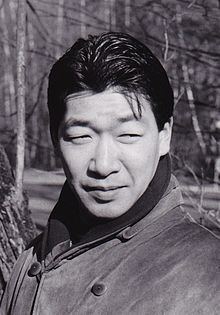Name Hiroshi Onishi | ||
 | ||
Envisioning the post capitalist economy hiroshi onishi
Hiroshi Ōnishi (大西 博) (June 18, 1961 – March 31, 2011) was a Japanese painter and university professor.
Contents
- Envisioning the post capitalist economy hiroshi onishi
- TrAIN Open Lecture Professor Hiroshi Onishi Media Art as a Medium Chaired by Dr Yuko Kikuchi
- Youth and Early Work
- Murals
- Academic Studies in Germany
- Return to Japan and Main Work
- A Retrospective of his Work
- Solo Exhibitions
- Group Exhibitions Selection
- Tea Ceremonies
- Literature
- References
TrAIN Open Lecture: Professor Hiroshi Onishi - Media Art as a Medium - Chaired by Dr Yuko Kikuchi
Youth and Early Work

Born on June 18, 1961, on Shikoku Island, in Tokushima Prefecture, he grew up in Osaka from the age of three. Two significant incidents during his childhood awakened his interest in Western culture: the 1970 World's fair in Osaka, and the instructions in Western painting by the artist Kakuichi Shikawa. When he was 12, his family moved to Tokyo, where he passed the entrance examinations for the Tokyo University of the Arts (Tōkyō Geijutsu Daigaku) in 1983. In 1989 he completed his studies with a Masters in Art Theory, specializing in Oil Painting, Technique and Materials. His thesis work “La Truite” (“The Trout”, 1987) was purchased by the Japanese Ministry of Culture. His second work, “The Salmon”, 1989 by the Daiwa Bank. During this phase, he oriented his work strongly toward the European Renaissance, in which his human forms are evocative of Albrecht Dürer or Matthias Grünewald, in combination with his conceptions of fish and water. After his academic studies he worked for one year as a research assistant in the Department of Oil Painting, Technique and Materials.
Murals
In subsequent years he created more surreal and expressive oil paintings. Simultaneously, from 1983 to 1992, he worked as a muralist for the department store Shibuya PARCO in Tokyo. Later in his writings, he called this job Kaisha ni okeru katsudō (in English, “the establishment-concerned workings”). On surfaces of 4.5 x 13m, respectively, 4.5 x 9m, he painted advertisements for various products on the exterior walls of the department store. In the beginning he painted solo, later he engaged additional artists for these assignments.
Academic Studies in Germany
From 1992 to 1997, Hiroshi Onishi studied at the Academy of Fine Arts in Nuremberg, Germany under Günter Dollhopf. In 1996 he was designated a Master Student. His experimentation with paper, acrylic, India ink, fabric and pigments became a quest for his Japanese roots.
Return to Japan and Main Work
In February 1998 he returned to Japan, initially to work as an Assistant Professor, later as a Professor, at his alma mater, Tokyo University of the Arts. In 2003, on assignment from the University, he undertook two trips to Afghanistan where he discovered the mineral lapis lazuli as a raw material for his work and rediscovered it as a pigment for traditional painting. This ultramarine pigment, created through an extremely complex process, he initially used for his painting and later for the creation of tea ceremony implements. Together with the Japanese company Holbein Ltd., he developed a premium quality lapis lazuli watercolor.
As Professor in the Department of Oil Painting, Technique and Material at the Tōkyō Geijutsu Daigaku he taught the traditional production of the lapis lazuli pigment in the tradition of Cennino Cennini from 1300 A.D.
Sensational exhibitions of this painting technique led to his most important and honored assignment: on the plot of a famous Zen Temple in Kyoto, the Nanzen-ji, he was to paint a hall in the Tenjuan Temple with his lapis lazuli technique. This work comprised 73 Fusuma-e (paintings on sliding doors). He was able to complete 12 Fusuma-e.
On March 31, 2011, he died in a boating accident on Lake Biwa, aged 49.
A Retrospective of his Work
From March 20 to April 8, 2012 the first show of his collective works took place posthumously on the campus of the Tōkyō Geijutsu Daigaku titled, “ONISHI HIROSHI Retrospective – View of Remembrance 大西博 回顧展 幻景“. Next to his many early works, oil paintings created using his lapis lazuli technique were also shown. In addition, the collection of tea ceremony utensils was presented for the first time. It consists of 30 ceremonial teacups fired with lapis lazuli pigment. Also included were accessories in bamboo and wood, which were lacquered with lapis lazuli pigment.
For Hiroshi Onishi the link between Eastern and Western painting was a central theme. A part of his work is now in Germany with his widow, Martina Wagner-Onishi.
Solo Exhibitions
Group Exhibitions (Selection)
Tea Ceremonies
On the occasion of the 120th Anniversary of the Tokyo University of the Arts, a four-day event „Geidai Chakai“ (tea convention of the Geidai) took place in October 2007. For this event, Hiroshi Onishi created multiple implements for tea ceremonies, among them the first teacup fired with a glaze of lapislazuli pigment. Additional public tea ceremonies followed.
